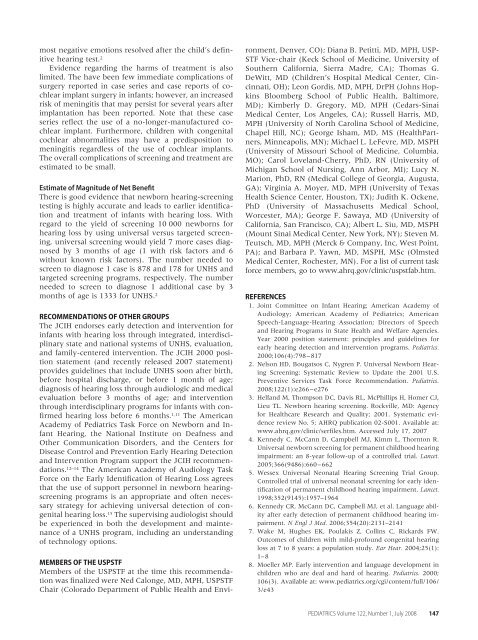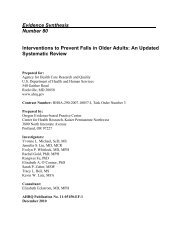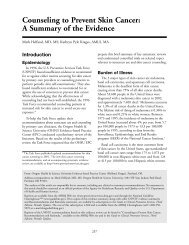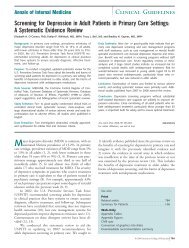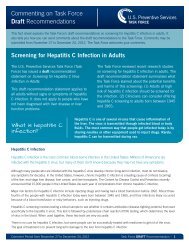Universal Screening for Hearing Loss in Newborns - US Preventive ...
Universal Screening for Hearing Loss in Newborns - US Preventive ...
Universal Screening for Hearing Loss in Newborns - US Preventive ...
You also want an ePaper? Increase the reach of your titles
YUMPU automatically turns print PDFs into web optimized ePapers that Google loves.
most negative emotions resolved after the child’s def<strong>in</strong>itivehear<strong>in</strong>g test. 2Evidence regard<strong>in</strong>g the harms of treatment is alsolimited. The have been few immediate complications ofsurgery reported <strong>in</strong> case series and case reports of cochlearimplant surgery <strong>in</strong> <strong>in</strong>fants; however, an <strong>in</strong>creasedrisk of men<strong>in</strong>gitis that may persist <strong>for</strong> several years afterimplantation has been reported. Note that these caseseries reflect the use of a no-longer-manufactured cochlearimplant. Furthermore, children with congenitalcochlear abnormalities may have a predisposition tomen<strong>in</strong>gitis regardless of the use of cochlear implants.The overall complications of screen<strong>in</strong>g and treatment areestimated to be small.Estimate of Magnitude of Net BenefitThere is good evidence that newborn hear<strong>in</strong>g-screen<strong>in</strong>gtest<strong>in</strong>g is highly accurate and leads to earlier identificationand treatment of <strong>in</strong>fants with hear<strong>in</strong>g loss. Withregard to the yield of screen<strong>in</strong>g 10 000 newborns <strong>for</strong>hear<strong>in</strong>g loss by us<strong>in</strong>g universal versus targeted screen<strong>in</strong>g,universal screen<strong>in</strong>g would yield 7 more cases diagnosedby 3 months of age (1 with risk factors and 6without known risk factors). The number needed toscreen to diagnose 1 case is 878 and 178 <strong>for</strong> UNHS andtargeted screen<strong>in</strong>g programs, respectively. The numberneeded to screen to diagnose 1 additional case by 3months of age is 1333 <strong>for</strong> UNHS. 2RECOMMENDATIONS OF OTHER GROUPSThe JCIH endorses early detection and <strong>in</strong>tervention <strong>for</strong><strong>in</strong>fants with hear<strong>in</strong>g loss through <strong>in</strong>tegrated, <strong>in</strong>terdiscipl<strong>in</strong>arystate and national systems of UNHS, evaluation,and family-centered <strong>in</strong>tervention. The JCIH 2000 positionstatement (and recently released 2007 statement)provides guidel<strong>in</strong>es that <strong>in</strong>clude UNHS soon after birth,be<strong>for</strong>e hospital discharge, or be<strong>for</strong>e 1 month of age;diagnosis of hear<strong>in</strong>g loss through audiologic and medicalevaluation be<strong>for</strong>e 3 months of age; and <strong>in</strong>terventionthrough <strong>in</strong>terdiscipl<strong>in</strong>ary programs <strong>for</strong> <strong>in</strong>fants with confirmedhear<strong>in</strong>g loss be<strong>for</strong>e 6 months. 1,11 The AmericanAcademy of Pediatrics Task Force on Newborn and Infant<strong>Hear<strong>in</strong>g</strong>, the National Institute on Deafness andOther Communication Disorders, and the Centers <strong>for</strong>Disease Control and Prevention Early <strong>Hear<strong>in</strong>g</strong> Detectionand Intervention Program support the JCIH recommendations.12–14 The American Academy of Audiology TaskForce on the Early Identification of <strong>Hear<strong>in</strong>g</strong> <strong>Loss</strong> agreesthat the use of support personnel <strong>in</strong> newborn hear<strong>in</strong>gscreen<strong>in</strong>gprograms is an appropriate and often necessarystrategy <strong>for</strong> achiev<strong>in</strong>g universal detection of congenitalhear<strong>in</strong>g loss. 15 The supervis<strong>in</strong>g audiologist shouldbe experienced <strong>in</strong> both the development and ma<strong>in</strong>tenanceof a UNHS program, <strong>in</strong>clud<strong>in</strong>g an understand<strong>in</strong>gof technology options.MEMBERS OF THE <strong>US</strong>PSTFMembers of the <strong>US</strong>PSTF at the time this recommendationwas f<strong>in</strong>alized were Ned Calonge, MD, MPH, <strong>US</strong>PSTFChair (Colorado Department of Public Health and Environment,Denver, CO); Diana B. Petitti, MD, MPH, <strong>US</strong>P-STF Vice-chair (Keck School of Medic<strong>in</strong>e, University ofSouthern Cali<strong>for</strong>nia, Sierra Madre, CA); Thomas G.DeWitt, MD (Children’s Hospital Medical Center, C<strong>in</strong>c<strong>in</strong>nati,OH); Leon Gordis, MD, MPH, DrPH (Johns Hopk<strong>in</strong>sBloomberg School of Public Health, Baltimore,MD); Kimberly D. Gregory, MD, MPH (Cedars-S<strong>in</strong>aiMedical Center, Los Angeles, CA); Russell Harris, MD,MPH (University of North Carol<strong>in</strong>a School of Medic<strong>in</strong>e,Chapel Hill, NC); George Isham, MD, MS (HealthPartners,M<strong>in</strong>neapolis, MN); Michael L. LeFevre, MD, MSPH(University of Missouri School of Medic<strong>in</strong>e, Columbia,MO); Carol Loveland-Cherry, PhD, RN (University ofMichigan School of Nurs<strong>in</strong>g, Ann Arbor, MI); Lucy N.Marion, PhD, RN (Medical College of Georgia, Augusta,GA); Virg<strong>in</strong>ia A. Moyer, MD, MPH (University of TexasHealth Science Center, Houston, TX); Judith K. Ockene,PhD (University of Massachusetts Medical School,Worcester, MA); George F. Sawaya, MD (University ofCali<strong>for</strong>nia, San Francisco, CA); Albert L. Siu, MD, MSPH(Mount S<strong>in</strong>ai Medical Center, New York, NY); Steven M.Teutsch, MD, MPH (Merck & Company, Inc, West Po<strong>in</strong>t,PA); and Barbara P. Yawn, MD, MSPH, MSc (OlmstedMedical Center, Rochester, MN). For a list of current task<strong>for</strong>ce members, go to www.ahrq.gov/cl<strong>in</strong>ic/uspstfab.htm.REFERENCES1. Jo<strong>in</strong>t Committee on Infant <strong>Hear<strong>in</strong>g</strong>; American Academy ofAudiology; American Academy of Pediatrics; AmericanSpeech-Language-<strong>Hear<strong>in</strong>g</strong> Association; Directors of Speechand <strong>Hear<strong>in</strong>g</strong> Programs <strong>in</strong> State Health and Welfare Agencies.Year 2000 position statement: pr<strong>in</strong>ciples and guidel<strong>in</strong>es <strong>for</strong>early hear<strong>in</strong>g detection and <strong>in</strong>tervention programs. Pediatrics.2000;106(4):798–8172. Nelson HD, Bougatsos C, Nygren P. <strong>Universal</strong> Newborn <strong>Hear<strong>in</strong>g</strong><strong>Screen<strong>in</strong>g</strong>: Systematic Review to Update the 2001 U.S.<strong>Preventive</strong> Services Task Force Recommendation. Pediatrics.2008;122(1):e266–e2763. Helfand M, Thompson DC, Davis RL, McPhillips H, Homer CJ,Lieu TL. Newborn hear<strong>in</strong>g screen<strong>in</strong>g. Rockville, MD: Agency<strong>for</strong> Healthcare Research and Quality; 2001. Systematic evidencereview No. 5; AHRQ publication 02-S001. Available at:www.ahrq.gov/cl<strong>in</strong>ic/serfiles.htm. Accessed July 17, 20074. Kennedy C, McCann D, Campbell MJ, Kimm L, Thornton R.<strong>Universal</strong> newborn screen<strong>in</strong>g <strong>for</strong> permanent childhood hear<strong>in</strong>gimpairment: an 8-year follow-up of a controlled trial. Lancet.2005;366(9486):660–6625. Wessex <strong>Universal</strong> Neonatal <strong>Hear<strong>in</strong>g</strong> <strong>Screen<strong>in</strong>g</strong> Trial Group.Controlled trial of universal neonatal screen<strong>in</strong>g <strong>for</strong> early identificationof permanent childhood hear<strong>in</strong>g impairment. Lancet.1998;352(9145):1957–19646. Kennedy CR, McCann DC, Campbell MJ, et al. Language abilityafter early detection of permanent childhood hear<strong>in</strong>g impairment.N Engl J Med. 2006;354(20):2131–21417. Wake M, Hughes EK, Poulakis Z, Coll<strong>in</strong>s C, Rickards FW.Outcomes of children with mild-profound congenital hear<strong>in</strong>gloss at 7 to 8 years: a population study. Ear Hear. 2004;25(1):1–88. Moeller MP. Early <strong>in</strong>tervention and language development <strong>in</strong>children who are deaf and hard of hear<strong>in</strong>g. Pediatrics. 2000;106(3). Available at: www.pediatrics.org/cgi/content/full/106/3/e43PEDIATRICS Volume 122, Number 1, July 2008 147


